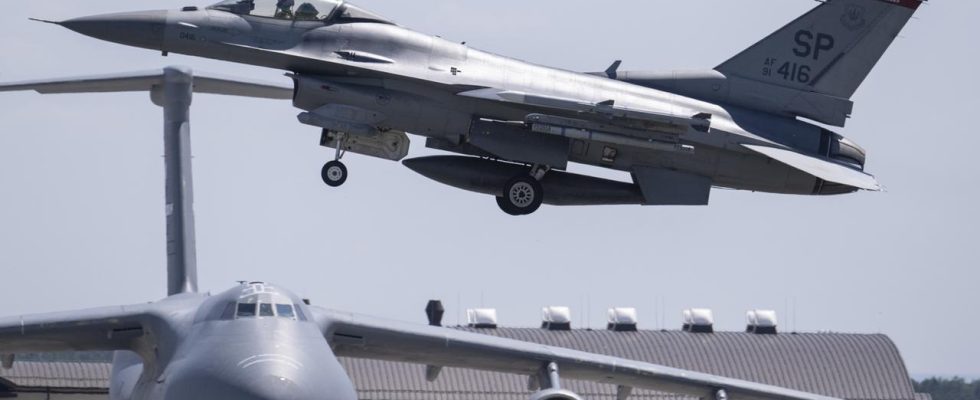The largest air force exercise in NATO history has been running since Monday. The effects on civil air traffic have so far been minor. But what does Air Defender actually do militarily?
Captain Tyler Knickerbocker is one of the US F-16 pilots who came to Germany for the “Air Defender” exercise. On the third day of the Luftwaffe maneuvers, his unit held a press conference at the Spangdahlem airbase in Rhineland-Palatinate.
So far, the exercise with more than 200 aircraft, in which 24 nations are taking part, has gone smoothly, he told the journalists. “I am very impressed with how the Germans have prepared this exercise. For younger, inexperienced pilots, it is a great opportunity to gain experience. They may never have had the opportunity to see so many aircraft in the airspace at the same time.”
Ute Otterbein, press spokeswoman for German air traffic control (DFS), reports that additional air traffic controllers will be deployed during the air exercises to guide both civil and military aircraft. “In Germany, air traffic control is integrated into civil and military systems. This means that all military aircraft are also managed by DFS. My colleagues take them to the training airspace. There they fly according to visual flight rules. After the exercise is over, we take them over returned to their bases.”
25 countries (green; USA and Japan not shown) are taking part in the NATO air force exercise “Air Defender 23”. The maneuver mainly takes place in three airspaces (shaded). There are also flights to NATO’s eastern border.
Delays so far within limits
Civil air traffic must be routed around these areas during exercise times. There may be delays. But they were limited in the first few days. On Monday there were only a few practice flights, and it wasn’t until Tuesday that things really got going. But even then, the delays were well below the forecast number. “There will only be a final evaluation after the exercise,” says Otterbein. “We have to evaluate the information from the regional control centers and correct the reasons for the delays that have nothing to do with ‘Air Defender’ – weather or other reasons. The validation will take some time.”
The forecast for Tuesday was 55,000 minutes of delay. But what does that actually mean? Otterbein gives a comparison: “If there is a thunderstorm in Germany, the delay is just as long. Even if the west runway is closed in Frankfurt due to a tailwind, we are dealing with around 30,000 minutes of delay per day.”
For these reasons, DFS does not want to say exactly how many minutes of delay have occurred so far. But the big air transfer exercise will last until June 23, and it cannot be ruled out that there will be longer delays.
Technical problems at the beginning
Lieutenant Colonel Matthias Boehnke, from the Air Force Press Information Center, appears relaxed on the phone. He receives inquiries from journalists from all over the world. He answers many questions, gives press conferences and keeps you informed about the progress of the exercise. “Everything has been running smoothly so far. Only at the beginning there were some coordination problems with the DARS, NATO’s deployable radar from Italy. It is responsible for controlling the training airspace east. There were some technical problems.”
Most pilots have never seen such a concentration of combat aircraft, transport aircraft and tanker aircraft. Modern jets like the F-35 have very specific data transmission requirements. The technology has to play along, otherwise it could be dangerous. But here, too, the Air Force officers are full of praise: “The German Air Force has done phenomenal work. It supports all the requirements of the international troops, and above all it takes care of the necessary IT,” says Nathaniel Hofmann, commodore at the 52nd US Army fighter squadron.
What brings “Air Defender” anyway?
The majority of the population is hardly aware of this gigantic exercise. Still, two years ago, a large-scale maneuver simulating a response to an attack by an imaginary military alliance from the east might have sparked more protests and unease. That changed during the period of Russian aggression in Ukraine.
Niklas Schörnig, senior researcher at the Leibniz Institute Hessian Foundation for Peace and Conflict Research in Frankfurt, emphasizes the usefulness of the exercise. Despite its defensive character, it has a deterrent effect on potential aggressors: “In any case, it is a clear signal that a quick reaction is being practiced in the event of a possible alliance. Since no ground troops are involved and it is essentially a transfer exercise , the provocation potential is low.”
“Confidence building Measure”
NATO has repeatedly emphasized that the exercise has nothing to do with the Russian attack on Ukraine. The evidence is that the planning had been going on for five years. Peace researcher Schörnig puts this explanation into perspective: “The planning of the exercise took place against the background of the annexation of Crimea in 2014. Since then, the threat to allies has been a possibility. The attack on Ukraine in 2022 shows that the fears of the eastern allies in particular are not were and are unfounded.”
In addition to an enormous training effect, which Commodore Nathaniel Hofmann describes as a “confidence-building measure”, “Air Defender” will certainly also contribute to increasing awareness of NATO worldwide. It was obviously also intended to counteract the accusation of “brain-dead NATO”.
When asked about the sustainability of such a demonstration of power, Lieutenant Colonel Boehnke said: “You always learn something. During the exercise, after each round, you evaluate and see what went well and what went less well, so that you can address this right away. After the exercise, it is then also a formal evaluation and a field report. This then helps us for future planning and exercises. Together we become stronger through exercises like ‘Air Defender 2023’.”

